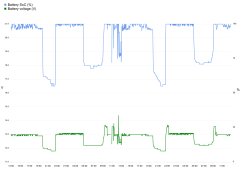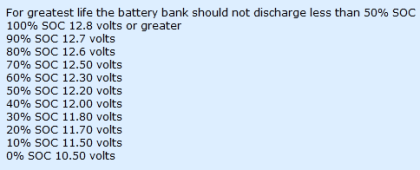Bast
New Member
Hi all,
Complete newbie here so go easy on me
I'm having a problem with my current PV setup: the battery seems to deplete far too quickly.
My set up is as follows:
Connected to the inverter (~230V) are:
So, for the sake of my question let's say a nominal load of around 100W on the inverter.
Now, if I'm not wrong, my battery should be able to handle that load for 130Ah x 12V = 1560Wh, 1560Wh / 100W = 15.6 hours, on a theoretical 100% DoD. The EPEVER seems to limit the DoD to about 50% though, so let's say 15.6 hours / 2 = 7.8 hours. That is 7.8 hours AT LEAST, because the nominal load is often much lower than 100W (see graph below).
What seems to happen is, as long as the PV is supplying power, the batteries stay at around 100% SoC. But as soon as the sun sets, the SoC seems to plunge according to the EPEVER. After that, SoC drops more slowly and the battery lasts for about 2/3 hours max before the battery SoC reaches 50% and the utility charger kicks in. On top of that the nominal load was way lower than 100W. More like 45W with some spikes to about 100W (see chart).
This is a graph of the past 24 hours (it looks about the same each day):

This is another graph, of the past 48 hours, with SoC plotted against the battery voltage:

(Ignore the weird spikes around 12:00, that was when I rebooted the EPEVER a few times)
Now if I understand correctly, the battery voltage will report the charger voltage when it is charging. So the drop in voltage when the sun sets could just be the charger cutting out, I guess. It drops from about 14V to 13V. I believe 13V is close to the under load voltage of a fully charged AGM. But that still does not explain why the EPEVER thinks that the SoC drops from 100% to about 65% almost instantly. So it seems to think 13V is 65% SoC. Also, it reports SoC as being around 55% when the battery voltage is at 12.6V. From what I gather 12.6V should roughly equal 85% SoC.
Off-topic observation: The PV output seems to follow the inverter load when the battery is fully charged (PV output is sitting at about 10W above the inverter load most of the time), I'm guessing the EPEVER limits the PV power to what is needed.
The battery is brand new by the way, so aging should not be a factor I think.
Now, the first thing that comes to mind is: the SoC reported must be wrong. No idea how the EPEVER calculates SoC. I recently read about how the only reliable way to measure SoC is using coulomb counters but I have no idea of the EPEVER has one buit in. It does report cumulative power consumption and charge quantity in kWh.
Second reason I could think of is that the battery settings are wrong. It has a AGM/sealed preset that it is currently set to, but also supplies a 'user' battery mode where I can specify various cut-off/reconnect voltages, but I'm afraid to touch that.
I'm not sure that the cut-off/reconnect voltages it reports over RS485 when it's not set to 'user' mode are the ones it's using now. In any case, these are the values reported:
In the graph above the EPEVER seems to switch over to utility charging when the battery is around 12.6V so I dont think it uses the above settings. I could not find the voltage tresholds for the AGM/Sealed profile in the manual so no idea what they are supposed to be.
These are the remaining settings on the EPEVER that I think might be relevant:
Ambient temperatures are currenly around 25-28 C during the day and 14-18 C during the night.
I'm at a loss. Am I missing something? Any ideas what's wrong?
P.S: Sorry for the information overload. I tried to be thorough.
Complete newbie here so go easy on me
I'm having a problem with my current PV setup: the battery seems to deplete far too quickly.
My set up is as follows:
- A charger/inverter: EPEVER UPower UP1000-M3212 (manual here, data sheet here)
- 2 x 160W panels: Enjoy Solar® Poly Solar Panel, 160 Watt, 12 Volt, Polycrystalline, wired in series (specs here)
- A single 130Ah 12V AGM deep cycle battery: EcoBat EDC12-110 (specs here)
Connected to the inverter (~230V) are:
- a small fridge that draws around 0-40W (and occasionally more than 40W)
- garden lighting that should draw around 20W (20 x 1W LED bulbs) but seems to draw around 80W according to the inverter (I'm sure this discrepancy can be explained somehow but my understanding of electronics is fairly limited). The lighting kicks in at sunset and switches off at 22:00.
- Occasionally I use it to charge an e-bike battery
So, for the sake of my question let's say a nominal load of around 100W on the inverter.
Now, if I'm not wrong, my battery should be able to handle that load for 130Ah x 12V = 1560Wh, 1560Wh / 100W = 15.6 hours, on a theoretical 100% DoD. The EPEVER seems to limit the DoD to about 50% though, so let's say 15.6 hours / 2 = 7.8 hours. That is 7.8 hours AT LEAST, because the nominal load is often much lower than 100W (see graph below).
What seems to happen is, as long as the PV is supplying power, the batteries stay at around 100% SoC. But as soon as the sun sets, the SoC seems to plunge according to the EPEVER. After that, SoC drops more slowly and the battery lasts for about 2/3 hours max before the battery SoC reaches 50% and the utility charger kicks in. On top of that the nominal load was way lower than 100W. More like 45W with some spikes to about 100W (see chart).
This is a graph of the past 24 hours (it looks about the same each day):

This is another graph, of the past 48 hours, with SoC plotted against the battery voltage:

(Ignore the weird spikes around 12:00, that was when I rebooted the EPEVER a few times)
Now if I understand correctly, the battery voltage will report the charger voltage when it is charging. So the drop in voltage when the sun sets could just be the charger cutting out, I guess. It drops from about 14V to 13V. I believe 13V is close to the under load voltage of a fully charged AGM. But that still does not explain why the EPEVER thinks that the SoC drops from 100% to about 65% almost instantly. So it seems to think 13V is 65% SoC. Also, it reports SoC as being around 55% when the battery voltage is at 12.6V. From what I gather 12.6V should roughly equal 85% SoC.
Off-topic observation: The PV output seems to follow the inverter load when the battery is fully charged (PV output is sitting at about 10W above the inverter load most of the time), I'm guessing the EPEVER limits the PV power to what is needed.
The battery is brand new by the way, so aging should not be a factor I think.
Now, the first thing that comes to mind is: the SoC reported must be wrong. No idea how the EPEVER calculates SoC. I recently read about how the only reliable way to measure SoC is using coulomb counters but I have no idea of the EPEVER has one buit in. It does report cumulative power consumption and charge quantity in kWh.
Second reason I could think of is that the battery settings are wrong. It has a AGM/sealed preset that it is currently set to, but also supplies a 'user' battery mode where I can specify various cut-off/reconnect voltages, but I'm afraid to touch that.
I'm not sure that the cut-off/reconnect voltages it reports over RS485 when it's not set to 'user' mode are the ones it's using now. In any case, these are the values reported:
| Boost charge voltage | 14.4V |
| Boost voltage reconnect | 13.2V |
| Float charging voltage | 13.8V |
| Low voltage disconnect | 10.8V |
| Low voltage reconnect | 12.5V |
In the graph above the EPEVER seems to switch over to utility charging when the battery is around 12.6V so I dont think it uses the above settings. I could not find the voltage tresholds for the AGM/Sealed profile in the manual so no idea what they are supposed to be.
These are the remaining settings on the EPEVER that I think might be relevant:
| Battery type | AGM/Sealed |
| Boost charging duration | 30 min |
| Battery capacity | 130 Ah |
| Charge source priority | Solar Priority |
| Discharging output mode | Battery |
Ambient temperatures are currenly around 25-28 C during the day and 14-18 C during the night.
I'm at a loss. Am I missing something? Any ideas what's wrong?
P.S: Sorry for the information overload. I tried to be thorough.
Last edited:





